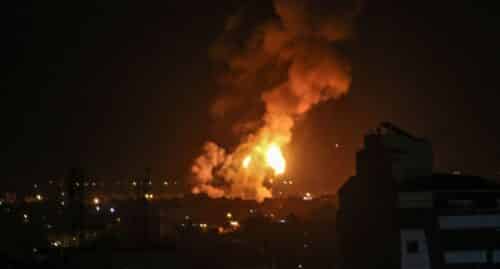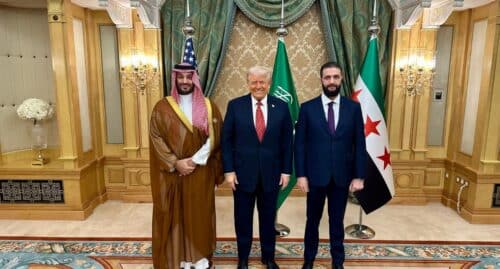While Israel is in over its head with an internal crisis and preoccupied with efforts to make it through a quiet Ramadan with the Palestinians, new significant challenges are emerging in the Iranian arena and in relation to the elements of power in Lebanon.
In the Iranian playing field – it is evident that the Islamic regime is looking into changing to rules of the game and scale up its uranium enrichment to military grade. In contrast to past statements made by US officials, among others by Secretary of Defense Panetta in 2012, explicitly stating that any attempt by Iran to develop nuclear weapons will be perceived by the US as a red line which implied such levels of uranium enrichment would not be tolerated, the Biden administration is conveying a more tolerant approach, at a time when it should be adopting a hardline policy in the face of real probability of a nuclear Iran. Head of the US Joint Chiefs of Staff General Milley said at the Congressional hearing on March 23 that the United States “remains committed, as a matter of policy, that Iran will not have a fielded nuclear weapon.” In other words, as far as the US is concerned, Iran can enrich uranium, even to a military grade, and go as far as to use it for producing nuclear warheads, but if it deploys such missiles – the US will respond.
Milley did add that the US military had developed multiple options for the leadership to consider in the event that Iran decides to go ahead with its nuclear arms development. This however, created considerable ambiguity in regards to whether America has redefined what it considers to be the red line. A National Security Council spokeswoman said in response the Milley’s statement that “the United States is committed to never allowing Iran to acquire a nuclear weapon”, reiterating the positions of former Presidents Obama and Trump and currently Biden, but did little to clarify whether Milley’s statement was misworded or that the Administration has indeed redefined its red lines and does not deem the production of military-grade uranium for the obvious purpose of nuclear weapons a move that demands response on part of the US.
Another example of this inertness can be seen in the meeting of the Board of Governors of the International Atomic Energy Agency (IAEA) earlier this month, in which the US refrained from demanding measures against Iran for its severe violation of the nonproliferation commitment with its nuclear enrichment efforts.
If the underlying message of America’s statements that military-grade enrichment is not a trigger for response on part of the Administration, then it indicates that Israel and the Administration in Washington do not see eye to eye on the matter. On the face of it, this discrepancy is no cause for concern since both parties claim that at this point, the Iranian regime has not yet given the nod for the production of nuclear arms and had not resume the activity of the weapons group, which was frozen in 2003. However, now disputes are arising regarding Iran’s nuclear breakout time. The general consensus is that at this point, Iran can produce enough fissile material for one nuclear warhead within less than two weeks, and for five nuclear warheads within three months. However, contrary to estimates until recently that even if the regime enriches military-grade uranium, they will need at least two years to produce a nuclear warhead that can be mounted on their long-range ballistic missiles, General Milley argues that Iran’s breakout time to a nuclear weapon could in fact be much shorter than that – possibly a matter of a few months (an opinion shared by David Albright, a senior nuclear expert at an American research institute. And to the best of my own judgment, the time required for the Iranians to do so may be much shorter than two years, given the recent progress they have already made in the production of uranium metal, the restricted supervision on the Iranian nuclear program, and the information discrepancies regarding the degree of progress made until 2003, which the Iranians insist on hiding, despite IAEA demands).
The shorter Iran’s breakout time is – the more significant and urgent the difference of opinions is between the US and Israel regarding the appropriate response to an Iranian push to military-grade uranium.
The current level of enrichment Iran has achieved – almost at military grade (60% and even perhaps 84%), the reconfiguration of the centrifuge cascades in the Fordow underground instillation such that enables the production of military grade material – all point to Iran’s growing audacity. Coupled with statements such as General Milley’s recent proclamations and a tepid response from the Administration in the IAEA meeting, might encourage Iran’s willingness to put the US (and Israel) to the test. This context may be the background to the growing number of attacks against US military bases in Syria, perpetrated by Iran’s proxies in Iraq and Syria, which have already claimed the life of an American contractor and wounded five others. Biden did issue a strong condemnation and the US retaliated by bombing an Iranian military base in northern Syria, but this doubtfully served as sufficient deterrence. At any rate, it is clear that Iran is deriving encouragement from its mounting regional and international status thanks to its recent agreements with Saudi Arabia, the tightening of its relations with China and Russia, America’s waning status in the region, the return of Syria’s president to the fold of the Arab world, and from Israel’s preoccupation with its internal strife and its reluctance to engage with Hezbollah.
The recent terrorist attack in Megido could be explained within this context, as it is viewed as an escalation of Iran’s Lebanese proxies’ audacity. Not much is known on the circumstances of the event, however, it is more than clear that an element of power in Lebanon, with relatively significant professional military know-how – including access to standard military explosives and the ability to cross the border – had decided to send into Israel’s territory a heavily armed terrorist and succeeded in doing so, miraculously wounding “only” one victim. No-one in Israel’s security establishment was aware of any intention, decision or instruction to execute the attack, and even in retrospect, it remains unclear whether Israeli Intelligence was able to determine how to prevent a reoccurrence of such an event.
In terms of intelligence, the attack was a multi-dimensional surprise, the gravest aspect of which was the fundamental level on which the security forces were caught unprepared. Israel’s security establishment operates on the assumption that the Lebanese elements in power are kept at bay by Israel’s military might and therefore avoid striking targets within the country’s borders, so long as Israel refrains from meddling in Lebanon’s vital interests, attacking Lebanon or targeting Hezbollah operatives in Syria as part of its campaigns between wars aimed against Iran and Hezbollah’s force-building efforts in Syria and Lebanon.
And yet, it appears that this assumption no longer holds true. There is an element of power in Lebanon that believes it can send terrorist to perpetrate attacks on Israeli soil – possibly even the Hezbollah itself or elements affiliated with the organization or with Iran (the likes of the Islamic Jihad, which in 2002 launched a terrorist attack across the Lebanese border into Israel, claiming the lives of 5 Israelis and bearing a resemblance to the recent attack). If this assumption is true, then something fundamental in Israel’s perception of the reality vis a vis Lebanon is off kilter. It appears that we have failed to understand that the recent changes in the system might change our enemy’s perception and lead them to adopt a new strategy. As I have warned in a previous article, and despite statements claiming that due to Israel’s hesitancy and its attempts to avoid confrontation with the Hezbollah over the gas agreement, concerns are growing that the organization’s confidence will grow and propel it to take what in Israel’s opinion would be uncalculated risks, but in Hezbollah’s perspective would be seen as an opportunity.
Indeed, the succession of new developments over the past months – Israel’s handling of the gas agreement, the rising influence of the Assad regime, the tightening relations between Iran and Russia, the agreements between Saudi Arabia and Iran lending tailwind to the extreme regime in Tehran, the escalation of tensions with the Palestinians in Samaria and on top of these – the internal rift in Israel – have compromised the restraints that the elements of power in Lebanon took into consideration in their situation assessments of Israel, and led one of them to adopt a new policy – or at least attempt to gauge the implications of such a policy through a test terrorist attack. It is true that Nasrallah had not claimed responsibility for the attack in his speech this week, however, he did try to set a new equation which permits the elements of power in Lebanon to launch attacks against Israel across the border (while hiding their identity and refraining from claiming responsibility), but Israel is prevented from responding, otherwise it can expect a harsh retaliation.
From the moment Israel identifies the perpetrator of the Megido terrorist attack – it must exact a high price, as it said it would. Failing to do so conveys the message – to other elements of power as well – that the controls have been relaxed and the opportunity is at hand to scale up Lebanese terrorism against Israel. On March 18, Hezbollah’s Al-Manar TV station broadcasted a video clip by the “Galilee Forces – The Lone Wolves”, produced by the organization that claimed responsibility for the Megido attack, in which it threatens to carry out more of the same, this time against government officials – including President Herzog. At this point, it is unclear whether there’s any substance to statements on part of the Palestinian Islamic Jihad organization, claiming that its operative Ali Ramzi al-Aswad, who was killed on March 19 in Damascus, was a target of Israeli activity, and whether his death is linked to the Megido attack. If it is so – then this is a highly appropriate retaliation.
Another, separate, issue is the situational surprise the attack presented. The IDF and other security forces were supposed to be prepared to intercept terrorist attack attempts from the border even without preliminary intelligence. There are good reasons to worry in light of the obscurity shrouding the affiliation of the terrorist, his intentions and the reasons for not using an explosive vest, whether other terrorist were trained and are in waiting, and whether the terrorist was Palestinian or Lebanese. All these are critical questions that demand an answer if Israel is to prevent the next attack. Hopefully the intensive investigation of the event will yield full answers shortly.
This complex and dangerous reality can explain at least partially, Defense Minister Galant’s call to hold the legislation related to the judicial review, and on the reserves soldiers to refrain from insubordination.
The views expressed in this article are those of the author and do not necessarily represent the views of the movement
This article was originally published in Hebrew by Mako: https://www.mako.co.il/news-columns/2023_q1/Article-bfe204d22541781026.htm
Photo credit: IDF Spokesperson.




